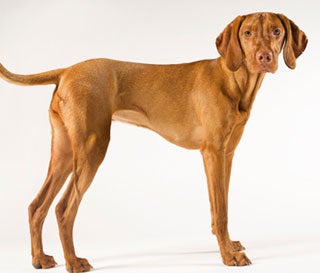Learn about dog breeds
Detailed information & photos on over 190 different breeds
Description
Among dog breeds, the silky and very muscular, average-sized Vizsla is truly a rare breed. Some people keep it as a pet while others use it for hunting because it possesses the alertness, stamina, and will that is well suited for pursuing a prey. Its limbs are straight and powerful. Like the Weimaraner, the Vizsla possesses an image of aristocracy because of its balanced built.
Its head is finely defined by a slightly-domed forehead with a line in the middle and a long and narrow line that gently connects its brown colored nose and mouth. Its well-built and sturdy neck and its restrained and deep chest justify its air of nobility. The Vizsla is a medium-sized dog that normally stands about 24 inches tall. The tail of a Vizsla is stopped around two-thirds of its normal length and its well developed feet are usually round.
The Vizsla’s eyes vary but usually, they are amber to yellow, complementing the shade of its coat. The round and pendant ears of this dog are usually long, extending to the level of the lower jaw.
Coat Description
The coat of the Vizsla is easy to maintain because its hair is silky and short, though thick. This is consistent throughout its body, legs, and face.
The Vizsla appears in different shades from coppery gold to rust shade. A Vizsla of yellow or mahogany may not be recognized by some clubs but any black in the coat is considered a serious blemish.
History
The origin of the Vizsla can be traced to the Magyar horde, a nomadic and traveling tribe in Central Europe that inhabited Hungary. During the eight century, Hungarian barons utilized the Vizsla for hunting as well as an emblem of wealth. Batthyany, Nadasdy and Zay families are its pioneer breeders. In the tenth century, the Vizsla breed was first depicted followed by its inclusion in the 14th century manuscript Illustrated Vienna Chronicle. Vizsla owners then primarily honed them for the fine arts, testing, pointing, retrieving, and sniffing.
Determined to guarantee the breed’s survival after WWI, The Hungarian Kennel Club (MEOE) initiated the formation and strict implementation of breed standards. However, Vizslas were nearly extinct after WWII. Fortunately, some Hungarians were able to save a few and started breeding them again. In 1971, the breed started to be recognized internationally. Today, Vizslas are highly regarded as effective participants in hunting challenges and other special shows.
Temperament
The Vizsla can be kept indoors as it is affectionate, expressive, and gentle. It is apt for the home as it is typically protective of the family or persons who own it. This dog is loyal and it is easily attached to its master to the extent that it follows its master wherever he or she goes, which is why it is also called a “Velcro” dog. The Vizsla is kind to children and get well together with other dogs. Unlike other dogs, it is quiet and barks only under certain circumstances. The Vizsla is great for hunting as it is good in tracking, retrieving, pointing, obeying, and watching.
Health Problems
Unfortunately, the effort to preserve the Vizsla breed through inbreeding gave birth to a prism of health issues. Although not all lines are affected, some of these health conditions include eye and stomach problems. The Vizsla may suffer from progressive retinal atrophy, entropion, ectropion, and corneal dystrophy while the stomach disease dysphagia-megaoesophagus may make it difficult for the dog to swallow. This is also characterized by muscle wasting and rampant drooling. The Vizsla may also become allergic to food and plants. Note that sebaceous adenitis causes its skin glands to swell as well.
Grooming
The Vizsla does not need expensive grooming. However, there is a need to ensure the cleanliness of its body. Regular bathe is advisable to make its coat shimmer and clean. Brush its coat on a weekly basis. Although it is not a heavy shedder, brushing would at least decrease its shedding as it removes dead hair. On the other hand, beautify its coat monthly with the use of a soft cloth to increase its shine.
Check the ears, eyes, and nails constantly to search out ticks and other parasites. You want to clean, you may use a cotton bud dipped into a dish of baby oil. Cleaning must be limited only around the ears. In case of water pollution, bring the dog to a veterinarian.
Exercise
The Vizsla is a sensitive dog that demands a sound lifestyle therefore consistent exercise is a must. You must engage it in walking, long running, jogging, and other active activities. It is receptive to challenges given to it in different places. This is not only good for its mental and physical growth but also for its socialization as the dog is allowed to get acquainted in various activities set in different settings.
Training
The Vizsla can be easily trained because of its intelligence. It not only learns to retrieve and point easily but it can master the basics – obedience, survival skills, toilet-training, socialization with humans and other animals – without much problems.
Training should start while the Vizsla is still young. It must be motivated with a reward, regular feeding and walking sessions. Take it out after eating or after drinking a lot of water. To prevent it from combating strangers and other dogs, get it used to socialization while at tender age. Generally, the Vizsla is a dog that loves pleasing people.
Advertise | Privacy Policy | Terms of Use | Contact Us © Copyright 2004-2024 PupCity.com. All rights reserved.
